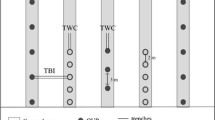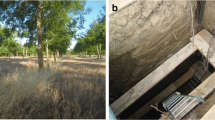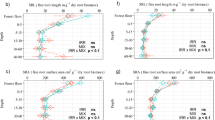Abstract
In designing agroforestry systems, the combination of tree genotype (orspecies) and pasture species and the spatial arrangement of trees are importantconsiderations. The spatial variation of fine root length density (FRLD) ofthree radiata pine (Pinus radiata D. Don) genotypes,referred to here as clone 3, clone 4 and seedlings, was studied in athree-year-old temperate silvopastoral experiment. The genotypes were plantedwith three understorey types: ryegrass (Lolium perenne)mixed with clovers (Trifolium spp), lucerne(Medicago sativa), and control (bare ground). Also fineroot distribution of both tree and pasture species with soil depth and inrelation to tree row (0.9 m north or south of and within the rippedtree row) was studied. Greater FRLD was found in clonal than in seedling treesin the bare ground treatment but not in the two pasture treatments, and in the0–0.1 m but not in the 0.1–0.2 or 0.2–0.3m soil layers. Clonal trees had a greater ability to develop a moreextensive root system, especially in the 0–0.1 m soil layer,but that advantage disappeared when they were planted with pasture species sincecompetition from the pasture species was most severe in the 0–10cm layer. The FRLD of lucerne was greater than that ofryegrass/clovers, consistent with the greater aboveground biomass production oflucerne. Pasture species FRLD was greater on the south (wetter) than on thenorth side of the ripline or in the ripline. The interception of prevailingsoutherly rain-bearing wind by tree crowns resulted in the south side beingwetter than the north side. Results indicated that production and distributionof fine roots of both tree and pasture species responded to changes in themicroclimate. We suggest that to optimize pasture/tree biomass productionplanting trees in the north-south direction is better than in the east-westdirection at the studied site.
Similar content being viewed by others
References
Anderson L.S. and Sinclair F.L. 1993. Ecological interactions in agroforestry systems. Agrofor Abst 6: 57-91.
Ares A. and Peinemann N. 1992. Fine-root distribution of conifer-ous plantations in relation to site in southern Buenos Aires, Argentina. Can J For Res 22: 1575-1582.
Avery T.E. and Burkhart H.E. 1983. Forest Measurements. 3rd edn. McGraw Hill Publishing Company, New York, 331 pp.
Bandara G. 1997. Ecophysiology of Clonal and Seedling Trees of Pinus radiata D. Don in an Agroforestry System. PhD Dissertation, Lincoln University, New Zeland (unpublished).
Bi H., Turvey N.D. and Heinrich P. 1992. Rooting density and tree size of Pinus radiata (D. Don) in response to competition from Eucalyptus obliqua (L' Herit). For Ecol Manage 49: 31-42.
Brown J.H. 1970. Seedling growth of three Scotch pine prove-nances with varying moisture and fertility treatments. For Sci 16: 43-45.
Chang S.X., Amatya G., Beare M.H. and Mead D.J. 2001. Soil properties under a Pinus radiata-ryegrass silvopastoral system in New Zealand. Part 1. Soil N and moisture availability, soil C, and tree growth. Agrofor Syst 54: 137-147.
Clinton P.W. 1990. Competition for nitrogen and moisture in a Pinus radiata-pasture agroforestry system. PhD Dissertation, University of Canterbury, New Zealand (unpublished).
Eastham J. and Rose C.W. 1990. Tree/pasture interactions at a range of tree densities in an agroforestry experiment. I. Root-ing patterns. Australian J Agri Res 41: 683-695.
Gautam M.K. 1998. Rooting characteristics of Pinus radiata D. Don as influenced by understorey conmpetition in an agrofor-estry system. PhD Dissertation, Soil, Plant and Ecological Sciences Division, Lincoln University.
Grime J.P., Crick J.C. and Rincon J.E. 1986. The ecological sig-nificance of plasticity. In: Jennings D.H. and Trewavas A.J. (eds), Plasticity in Plants. Cambridge University Press, pp. 5-29.
Hendrick R.L. and Pregitzer K.S. 1993. Patterns of fine root mortality in two sugar maple forests. Nature 361: 59-61.
Heth D. 1980. Root and shoot water potential in stressed pine seedlings. NZ J For Sci 10: 142-147.
Hughes K.A., Gandar P.W., Menalda P.H. and Snow V.O. 1986. A Survey of Kiwi Fruit Root Systems. Technical Report No. 22. Plant Physiology Division, DSIR, Palmerston North, New Zealand.
Jonsson K., Fidjeland L., Maghenbe J.A. and Hogberg P. 1988. The vertical distribution of five tree species and maize in Morogoro, Tanzania. Agrofor Syst 6: 63-69.
Mead D.J., Lucus R.J. and Mason E.G. 1993. Studying interactions between pastures and Pinus radiata in Canterbury's sub-humid temperate environment-the first two years. NZ For 38: 26-31.
Nambiar E.K.S. 1980. Root configuration and root regeneration in Pinus radiata seedlings. NZ J For Sci 10: 249-263.
Nambiar E.K.S. 1983. Root development and configuration in intensively managed radiata pine plantations. Plant Soil 71: 37-47.
Nambiar E.K.S. 1984. Significance of first order lateral roots on the growth of young radiata pine under environmental stress. Australian For Res 14: 187-199.
Ong C.K. 1991. Interaction of light, water and nutrients in agro-forestry systems. In: Avery M.E., Cannell M.G.R. and Ong C.K. (eds), Biophysical Research for Asian Agroforestry. Winrock International, USA, pp. 107-124.
Richards D., Goubran F.H., Garwoli W. and Daly M.W. 1979. A machine for determining root length. Plant Soil 52: 69-76.
Ritchie G.A., Tanaka Y. and Duke S.D. 1992. Physiology and mor-phology of Douglas-fir rooted cuttings compared to seedlings and transplants. Tree Physiol 10: 179-194.
Sasse J. 1994. Comparisons of the morphology and physiology of cuttings and seedlings of Eucalyptus globulus. PhD Dissertation, University of Melbourne, Australia (unpublished).
Stokes A., Nicoll B.C., Coutts M.P. and Fitter A.H. 1997. Response of young Sitka spruce clones to mechanical perturbation and nutrition: effects on biomass allocation, root development, and resistance to bending. Can J For Res 27: 1049-1057.
Theodorou C. and Bowen G.D. 1993. Root morphology, growth, and uptake of phosphorous and nitrogen of Pinus radiata families in different soils. For Ecol Manage 56: 43-56.
Theodorou C., Cameron J.N. and Bowen G.D. 1991. Growth of roots of different Pinus radiata genotypes in soil at different strength and aeration. Australian For 54: 52-59.
Vogt K.A. and Persson H. 1991. Measuring growth and development of roots. In: Lassoie J.P. and Hinckley T.M. (eds), Techniques and Approaches in Forest Tree Ecophysiology. CRC Press, USA, pp. 477-502.
Yunusa I.A.M., Mead D.J., Pollock K.M. and Lucas R.J. 1995a. Process studies in a Pinus radiata-pasture agroforestry system in a subhumid temperate environment. I. Water use and light interception in the third year. Agrofor Syst 32: 163-183.
Yunusa I.A.M., Mead D.J., Pollock K.M. and Lucas R.J. 1995b. Process studies in a Pinus radiata-pasture agroforestry system in a subhumid temperate environment. II. Analysis of dry matter yield in the third year. Agrofor Syst 32: 185-204.
Author information
Authors and Affiliations
Corresponding author
Rights and permissions
About this article
Cite this article
Gautam, M., Mead, D., Chang, S. et al. Spatial variation and understorey competition effect of Pinus radiata fine roots in a silvopastoral system in New Zealand. Agroforestry Systems 55, 89–98 (2002). https://doi.org/10.1023/A:1020559624831
Issue Date:
DOI: https://doi.org/10.1023/A:1020559624831




